Related Research Articles

Elmo Russell "Bud" Zumwalt Jr. was a United States Navy officer and the youngest person to serve as Chief of Naval Operations. As an admiral and later the 19th Chief of Naval Operations, Zumwalt played a major role in United States military history, especially during the Vietnam War. A decorated war veteran, Zumwalt reformed United States Navy personnel policies in an effort to improve enlisted life and ease racial tensions. After he retired from a 32-year navy career, he launched an unsuccessful campaign for the United States Senate.
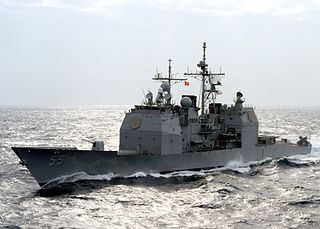
USS Leyte Gulf (CG-55) is a Ticonderoga-class guided missile cruiser in the United States Navy. She was named in memory of the World War II Battle of Leyte Gulf in the Pacific. She is powered by four large gas-turbine engines, and she has a large complement of guided missiles for air defense, attack of surface targets at sea and ashore, and anti-submarine warfare (ASW). In addition, she carries two "Seahawk" LAMPS multi-purpose helicopters, whose primary mission is ASW.

The surface warfare insignia is a military badge of the United States Navy which is issued to U.S. Navy personnel who are trained and qualified to perform duties aboard United States surface warships. There are presently four classes of the surface warfare pin, being that of line, staff, special operations, and enlisted. The line and enlisted surface warfare badges may be earned by United States Coast Guard personnel assigned to Navy commands. The various badge types are as follows:
There are three major types of submarines in the United States Navy: ballistic missile submarines, attack submarines, and cruise missile submarines. All submarines in the U.S. Navy are nuclear-powered. Ballistic missile submarines have a single strategic mission of carrying nuclear submarine-launched ballistic missiles. Attack submarines have several tactical missions, including sinking ships and subs, launching cruise missiles, and gathering intelligence.

The quarterdeck is a raised deck behind the main mast of a sailing ship. Traditionally it was where the captain commanded his vessel and where the ship's colours were kept. This led to its use as the main ceremonial and reception area on board, and the word is still used to refer to such an area on a ship or even in naval establishments on land. Many such facilities have areas decorated like shipboard quarterdecks.

Ellsworth Price Bertholf was a Congressional Gold Medal recipient who later served as the fourth Captain-Commandant of the United States Revenue Cutter Service and because of the change in the name of the agency in 1915, the fourth Commandant of the United States Coast Guard. His leadership during his tenure as Commandant was critical to the U.S. Coast Guard's survival at a time when outside agencies wanted to either take it over or split its missions up among several agencies.
An unrestricted line officer is a designator given to a commissioned officer of the line in the United States Navy, who is eligible for command at sea of the navy's warfighting combatant units such as warships, submarines, aviation squadrons and SEAL teams. They are also eligible to command the higher echelons of those units, such as destroyer and submarine squadrons, air wings and air groups, and special warfare groups.
Seafaring is a tradition that encompasses a variety of professions and ranks. Each of these roles carries unique responsibilities that are integral to the successful operation of a seafaring vessel. A ship's crew can generally be divided into four main categories: the deck department, the engineering department, the steward's department, and other. The reasoning behind this is that a ship's bridge, filled with sophisticated navigational equipment, requires skills differing from those used on deck operations – such as berthing, cargo and/or military devices – which in turn requires skills different from those used in a ship's engine room and propulsion, and so on.
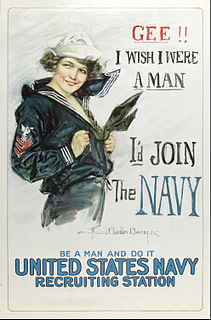
The uniforms of the United States Navy include dress uniforms, daily service uniforms, working uniforms, and uniforms for special situations, which have varied throughout the history of the navy. For simplicity in this article, officers refers to both commissioned officers and warrant officers.
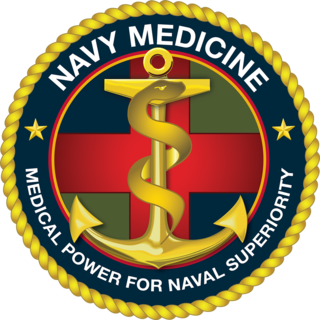
The Bureau of Medicine and Surgery (BUMED) is an agency of the United States Department of the Navy that manages health care activities for the United States Navy and the United States Marine Corps. BUMED operates hospitals and other health care facilities as well as laboratories for biomedical research, and trains and manages the Navy's many staff corps related to medicine. Its headquarters is located at the Defense Health Headquarters in Fairfax County, Virginia. BUMED has 63,000 medical personnel and more than a million eligible beneficiaries.
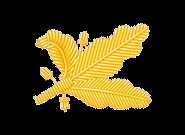
The Navy Supply Corps is the United States Navy staff corps concerned with supply, logistics, combat support, readiness, contracting, and fiscal matters.

The United States Navy occupational rating of boatswain's mate is a designation given by the Bureau of Naval Personnel (BUPERS) to enlisted members who were rated or "striking" for the rating as a deck seaman. The colloquial form of address for a boatswain's mate is "Boats".

The United States Navy (USN) is the maritime service branch of the United States Armed Forces and one of the eight uniformed services of the United States. It is the largest and most powerful navy in the world, with the estimated tonnage of its active battle fleet alone exceeding the next 13 navies combined, including 11 U.S. allies or partner nations as of 2015. It has the highest combined battle fleet tonnage and the world's largest aircraft carrier fleet, with eleven in service, two new carriers under construction, and five other carriers planned. With 336,978 personnel on active duty and 101,583 in the Ready Reserve, the U.S. Navy is the third largest of the U.S. military service branches in terms of personnel. It has 290 deployable combat vessels and more than 2,623 operational aircraft as of June 2019.
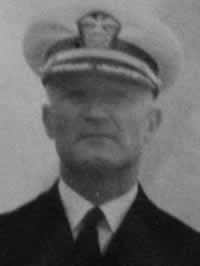
MacGillivray Milne was a United States Navy captain, and the 27th governor of American Samoa from January 20, 1936, to June 3, 1938. After graduating from the United States Naval Academy, Milne served many posts in the Navy, including heading the Department of Modern Languages at the Naval Academy. He was a veteran of a large numbers of conflicts, including the Philippine–American War, the United States occupation of Veracruz, and both World War I and World War II. Milne commanded a number of ships, but his last one was the battleship USS Arizona (BB-39). After the ship struck a private fishing vessel and killed two civilians, Milne was court-martialed and stripped of three grades which determined his eligibility for promotion. As governor, Milne pushed for the modernization of American Samoa, and sought increased federal aid for the islands; his efforts to obtain additional funding for the island largely ended in failure. He died in 1959 at the Naval Hospital Oakland, and was buried in Sparkill, Rockland County, New York.
A ship's company comprises all officers, non-commissioned officers and enlisted personnel aboard a naval vessel. The size of the ship's company is the number of people on board, excluding civilians and guests.

Thomas Francis Darden Jr. was a U.S. Navy officer who achieved the rank of captain, the commander of a Navy light cruiser during World War II, and was the 37th Governor of American Samoa from July 7, 1949 through February 23, 1951. Darden also served on the staffs of two U.S. Navy admirals during the War in the Pacific: rear admirals Henry Hughes Hough and Thomas L. Sprague.

Kenneth Whiting was a United States Navy officer who was a pioneer in submarines and is best known for his lengthy career as a pioneering naval aviator. During World War I, he commanded the first American military force to arrive in Europe for combat. After the war, he was instrumental in development of the aircraft carrier in the United States, where he sometimes is known as the U.S. Navy's "father of the aircraft carrier." He was involved in some way in the design or construction of five of the first six U.S. Navy aircraft carriers, and served as acting commanding officer of the first carrier to enter U.S. Navy service and as executive officer of the first two American carriers. In the earliest days of the U.S. Navy's development of an aircraft carrier force, he led many shipboard innovations still in use aboard carriers today.
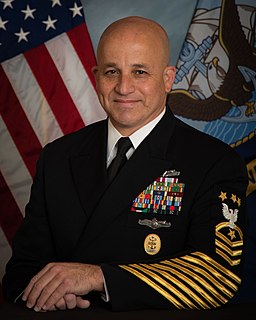
Russell L. Smith is a United States Navy sailor who serves as the 15th Master Chief Petty Officer of the Navy (MCPON). He was acting MCPON from June 22, 2018, when Steven S. Giordano resigned, to August 29, 2018, when he officially assumed the role.
References
- 1 2 3 Mayo, Claude Banks (1939). Your Navy. Los Angeles: Parker & Baird Company. pp. 307&308.